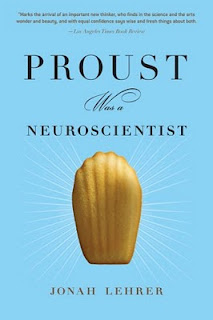You are here
Video Conferencing in the Classroom
Primary tabs

Hardcover edition of Lehrer, Proust Was a Neuroscientist
In this classroom activity, a scholar/expert whose work is on your syllabus visits the classroom via Skype or another conferencing tool. The visit doesn’t require much of a time commitment or advance preparation on the part of your invitee, but it has a big payoff in terms of bringing students in conversation with a noted off-campus scholar or expert.
To connect our classroom discussions with what's going on outside the classroom.
To inspire students through a conversation with an outside expert (in our case, the science writer Jonah Lehrer).
Skype (available on DWRL computers) or another video-conferencing tool
In this classroom activity, a scholar/expert whose work is on your syllabus visits the classroom via Skype or another conferencing tool. The activity follows an in-class discussion about the scholar's work, allowing students to engage with the reading and its author in a different way. Asking students to prepare questions in advance allows for a more focused and lively discussion.
Although I used this activity in a literature course, it would work well in a rhetoric course, perhaps even a 306 or 309S/K, where students might interact with a stakeholder in a controversy being discussed that semester.
1. Contact the scholar as far in advance as possible about the visit to your class. Be flexible about the date of the visit.
2. As the date approaches, let the scholar know in advance which book excerpts/articles you have assigned in class, so that he or she is on the same page. Also, use this opportunity to arrange logistical details and maybe even to do a test conference on a DWRL computer.
3. For the class period before the speaker's visit, have each student submit a question for the visitor (ideally, this class would also be used to discuss the scholar's work, so that you the visit is an extension of that converstaion). I had students use the Drupal forum on our course website to post their question; they had about 10 minutes at the end of class to formulate a query.
4. On the day of class, log onto skype using the teacher computer. As per the previous arrangement, have the visitor call in, or call him/her when you are ready. Feel free to mediate the discussion using the questions submitted in Step Three. Unless the speaker's time is limited, be prepared to spend the full class period in conversation with the speaker.
I did not give students a prompt for the activity, but I did give them advance notice about the speaker's attendance and an overview of how the class would be run that day.
This activity was not evaluated.
The activity was a success in that our speaker (Jonah Lehrer) was quite engaging, and, based on our conversation during the next class, students enjoyed the visit. However, there were two main issues (possibly related) that you might consider when customizing the activity:
1. Student silence. My normally talkative class grew quiet when confronted with a disruption to our usual dynamic. The list of questions that I'd collected in advance were helpful in this regard, but you might consider other measures to get them going, like placing some students in charge of asking their peers' questions and interacting with the speaker.
2. Interactivity of speaker and students. In our set-up, the conferencing interface was projected on a large screen in the classroom, so that students could easily see the speaker. One drawback is that I had to be a liaison between the students and Lehrer; he could hear but not necessarily see all of them, as the computer’s video camera was not facing the class. This arrangement made true conversation/interaction difficult at times.
Alternatively: Jim Brown, who inspired this lesson, suggested gathering students around a single computer. This arrangement would allow students to communicate directly with the visitor (and vice versa), but might not be feasible if you have a class larger than 10 or 12 students.
“We are made of art and science. We are such stuff as dreams are made on, but we are also just stuff.” –Jonah Lehrer, Proust Was a Neuroscientist
What does it mean to be human? Why do we behave the way we do? What’s the difference between life and non-life, organism and machine? Where are we (the human species, the planet Earth) headed next?
Acknowledging the obvious and meaningful differences in methods and outlook, one might argue that both writers and biologists travel similar terrain, presenting themselves as (often competing) authorities on the “big questions” about Life.
Instead of seeing literature and biology as necessarily antagonistic ways of looking at and understanding the world, in this course we will read literature about science and literary science writing for their complementary insights. What do literature and biology look like at their interface? How do the scientific paradigms of their day influence how writers grapple with questions of human experience, identity, and ethics? In turn, how do literary narratives about evolutionary biology or genetics shape the way we think about these disciplines, the way they’re understood by non-scientists?
No expertise in biology or in literary criticism will be presumed. The broad goals of this course will be to introduce students to the basic tools of literary analysis and to develop students’ own critical writing.
-

- Log in to post comments

